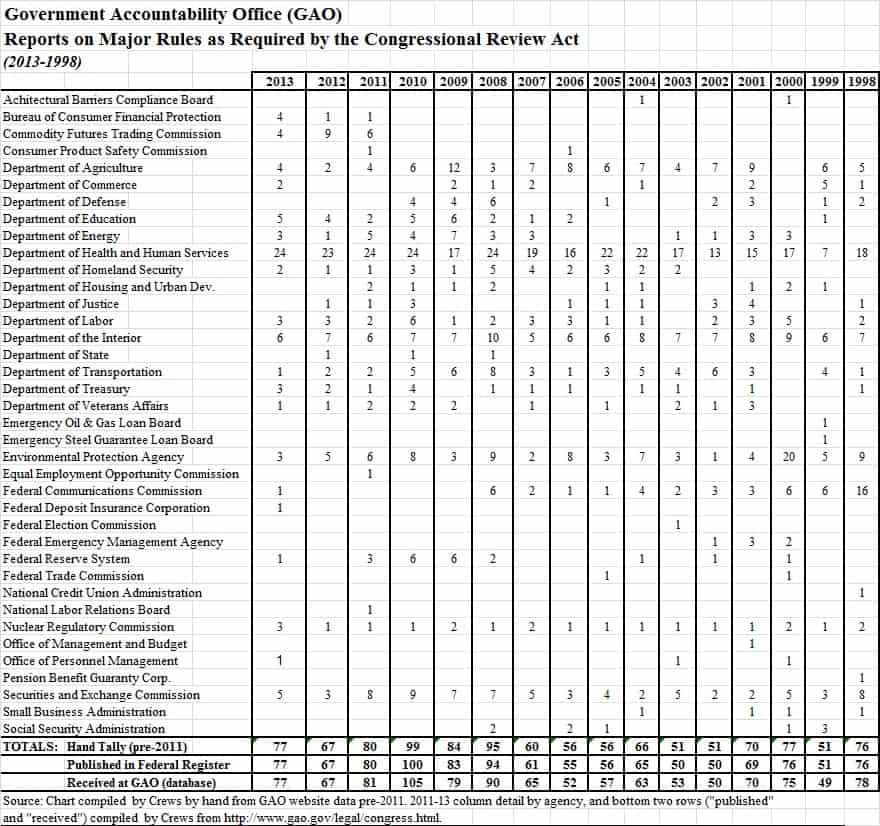Red Tapeworm 2014: The Government Accountability Office Reports More Regulations in Obama Era

This is Part 25 of a series taking a walk through some sections of Ten Thousand Commandments: An Annual Snapshot of the Federal Regulatory State (2014 Edition)
Executive Orders, guidance documents, memoranda and other “non-rules” evade notice-and-comment and the federal Office of Management and Budget’s review mechanisms.
Yet even when rules do undergo notice and comment prodecures it may not be sufficient. A new study finds that over the past couple years, final rules increasingly are not being submitted to the Government Accountability Office (GAO) and to Congress as is required under the 1996 Congressional Review Act (CRA).
The CRA requires agencies to submit reports to Congress on their major rules—defined roughly as those costing $100 million or more. Owing to such reports, maintained in a database at the GAO, one could more readily observe which of the thousands of final rules agencies issue each year are major and which agencies are producing the rules.
The neglect of this submission is a significant lapse. The reports are essential in case Congress opts to introduce a formal Resolution of Disapproval of an agency rule under the CRA.
The CRA gives Congress a 60 legislative day window in which to review a major rule and, if desired, pass such a resolution of disapproval. The reports are required for this very reason.
Despite the issuance of thousands of rules since the act’s passage, including many dozens of major rules, only one has been rejected: the Labor Department’s rule on workplace repetitive-motion injuries in early 2001. This is one of the reasons some support a required affirmation of major rules by Congress, not merely the option to disapprove one, to re-establish congressional accountability for agency actions.
The table nearby, derived from the GAO database of major rules, depicts the number of final major rule reports issued by the GAO on agency rules through 2013. There were 77 rules in 2013, 67 in 2012 and 80 in 2011. The 99 rules in 2010 had been the highest number since this tabulation began following passage of the CRA. Note however, that with the disclosure that recent years’ rules have not been submitted to Congress and GAO, newer counts should be higher. Further analysis will clarify this matter.

Nonetheless, mirroring the most active executive and independent agency rulemakers as determined by rules in the pipeline, Department of Health and Human Services, the Securities and Exchange Commission and the Commodity Futures Trading Commission may be seen to be increasingly active in terms of major rules in wake of the Affordable Care Act and the Dodd-Frank financial regulation law.
President George W. Bush averaged 63 major rules annually during his eight years in office; Obama’s five years so far have averaged 81—but this appears now to be an undercount. Obama’s output level in his first term is already 29 percent hight than that of Bush’s last term. This parallels economically significant rules under Obama, notably higher despite talk about regulatory lookbacks and reductions.
But greater levels of rules are unsurprising in the wake of the Affordable Care Act and the Dodd-Frank financial regulation law. The Department of Health and Human Services, the Securities and Exchange Commission and the Commodity Futures Trading Commission are becoming increasingly active in terms of major rules.
A May 2013 Heritage Foundation analysis of the current administration’s regulatory record isolated the major rules listed in the GAO database affecting only the private sector, and it further distinguished between those that are deregulatory and those that are regulatory. That compilation found that 131 major rules were adopted during the Obama adminstration’s first term, for an increase of almost $70 billion in annual costs.
2014 Red Tapeworm Series:
Part 1: Guess Which Is the Largest Government on Earth?
Part 2: Tardy Bureaucrats Gone Wild
Part 3: Reckoning the Dollar Cost of Federal Regulation
Part 4: Regulations Catching Up to Government Spending?
Part 5: Regulations Cost More than Federal Income Taxes
Part 6: The Federal Government “Eats” 31 Percent Of The U.S. Economy
Part 7: U.S. Regulation Compared to the World’s Largest Economies
Part 8: The High Cost of Overcriminalization
Part 9: Thousands of Federal Register Pages
Part 10: A Record Number of Federal Register Final Rule Pages
Part 11: Federal Register Pages Per Decade
Part 12: Number of Proposed and Final Rules In the Federal Register
Part 13: Cumulative Final Rules in the Federal Register
Part 14: The Expanding Code of Federal Regulations
Part 15: A Fourth of July Reflection on Presidential Executive Orders and Loss of Liberty
Part 16: Over 24,000 Pen and Phone “Public Notices” Annually
Part 17: When Regulations Get Delayed
Part 18: Federal Regulatory Disclosure Becomes More Confused
Part 19: Federal Regulatory Agenda Consistently Tops 3,000 Rules
Part 20: Here Are the Federal Agencies that Issue the Most Regulations
Part 21: Big Dollar Federal Regulations in the Pipeline Highest Under Obama
Part 22: Completed Economically Significant Rules at Record Levels
Part 23: Small Businesses Beaten Down By Recordbreaking Federal Regulations
Part 24: Tell Us—Which Regulations Hurt Your Business As You Grow?